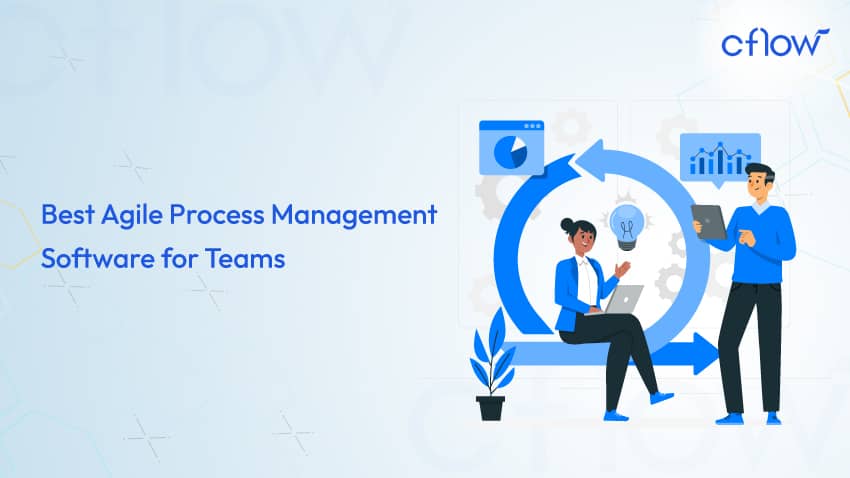Best Agile Process Management Software for Teams

Agile is more than a buzzword; it’s a proven strategy for building resilient, high-performing teams. To support agile practices effectively, teams need the best agile process management software for teams. These tools enhance collaboration, streamline workflows, and provide real-time visibility into project progress.
Whether you are a startup or an enterprise, investing in the right agile workflow tools for collaboration ensures that teams stay connected, productive, and aligned. This blog explores the top agile software for productivity, their features, and how they help teams embrace agility in a dynamic work environment.
What is Agile Process Management Software?
Agile process management software refers to digital platforms designed to help teams plan, organize, and deliver projects efficiently by following agile principles. The best agile process management software for teams combines task boards, sprint planning tools, real-time collaboration features, and workflow automation to streamline every stage of project execution. These tools bridge communication gaps between team members, ensure seamless distribution of work, and enhance visibility through advanced reporting dashboards. From comprehensive agile project management platforms to specialized tools for agile team collaboration, these solutions are critical for enabling faster delivery cycles, improving team accountability, and maintaining consistent value creation in dynamic work environments.
Importance of Agile Workflow Tools for Collaboration
Effective collaboration is crucial for agile success. In fact, connected employees are 20–25% more productive, highlighting the importance of agile collaboration tools in remote and hybrid environments.
Agile workflow tools for collaboration foster open communication, transparency, and team accountability. They allow distributed teams to share updates in real time, track task progress collectively, and maintain visibility across sprint backlogs and project goals. By investing in collaborative agile software solutions, organisations build stronger, more connected teams that deliver better results faster.
In addition to improving team dynamics, agile workflow tools streamline project management processes by centralising communication and task tracking. Teams can identify bottlenecks early, adjust priorities swiftly, and ensure that project goals stay aligned with customer needs. As agile practices continue to evolve, adopting the right collaboration tools becomes essential for maintaining speed, flexibility, and long-term success.
Key Features of Agile Project Management Platforms
When selecting the best agile process management software for teams, it is essential to look for a range of key features that support both flexibility and speed in project delivery.
1. Customizable Workflows
The ability to tailor workflows for Scrum, Kanban, or hybrid frameworks is crucial. Customizable boards allow teams to organize tasks according to their unique agile methodologies, ensuring that the software aligns perfectly with existing processes rather than forcing teams to adapt to rigid structures.
2. Real-Time Tracking
Real-time agile tracking tools help teams monitor progress continuously. These tools provide live updates on task statuses, sprint goals, and individual workloads, enabling teams to quickly identify blockers and adjust priorities without waiting for end-of-sprint reviews.
3. Backlog Management
Effective backlog management is at the core of agile planning. Agile platforms should make it easy to prioritize tasks, create user stories, and rearrange items dynamically as project needs evolve. This ensures that teams are always working on the most valuable tasks.
4. Integration Support
Agile teams often rely on multiple tools. Strong integration support allows agile process management software to connect seamlessly with collaboration and development platforms like Slack, GitHub, Microsoft Teams, and others. Integrations streamline communication and keep workflows centralised.
5. Reporting and Dashboards
Robust reporting and dashboard capabilities are essential for tracking key performance indicators (KPIs) and team productivity. Visual dashboards provide insights into sprint velocity, burndown rates, and workload distribution, helping leaders make informed, data-driven decisions.
6. Cloud-Based Access
Modern teams need flexibility. Choosing cloud-based agile management software ensures that team members can access projects, update tasks, and collaborate from anywhere. This is especially important for distributed or hybrid teams that require real-time connectivity across locations.
These capabilities ensure that teams can plan, execute, and adapt projects efficiently, supporting continuous delivery and improvement in an agile environment.
End-to-end workflow automation
Build fully-customizable, no code process workflows in a jiffy.
Best Agile Process Management Software for Teams
As demand rises, the agile project management software market is projected to reach $9.3 billion by 2027, emphasizing the need for teams to choose the right platform today. Here is a list of the top Agile software for productivity:
1. Cflow: No-Code Agile Platform for Teams
Cflow is a no-code workflow automation platform built to automate workflows while supporting agile processes. It enables businesses to quickly build, modify, and deploy workflows without writing a single line of code, making it ideal for agile product teams.
Features
- Visual Workflow Builder for agile processes
- Drag-and-drop Form Designer for custom task forms
- Kanban Boards for task visualization
- Mobile Accessibility for remote teams
- Advanced Reporting for sprint tracking
- Integration with Slack, Zapier, and Google Drive
- Role-Based Access Control for secure collaboration
Pros
- Highly customisable with a user-friendly interface
- Great for businesses embracing agile process automation
- Affordable for growing teams
Cons
- Limited features in the basic plan
2. Jira Software: Comprehensive Scrum Software for Teams
Jira Software is a leading choice among agile teams seeking Scrum, Kanban, or hybrid project management frameworks. It offers extensive features that scale well for businesses of all sizes.
Features
- Scrum and Kanban boards
- Backlog prioritisation and sprint planning
- Burndown charts and velocity tracking
- Integration with Confluence, Bitbucket, and Slack
- Workflow automation rules
Pros
- Scales well for large teams
- Excellent reporting features
- Highly customisable workflows
Cons
- Steep learning curve for beginners
- Interface can be complex for non-technical users
- Cost increases significantly with advanced features
3. ClickUp: Agile Tools for Remote Teams
ClickUp is a modern project management tool that supports agile workflows, making it an excellent choice for remote and distributed teams seeking flexibility.
Features
- Customizable Agile boards
- Sprint planning tools and backlogs
- Real-time team collaboration
- Goal setting and tracking
- Automation for repetitive tasks
Pros
- Highly flexible and versatile
- User-friendly interface
- Rich in collaboration features
Cons
- Can be overwhelming due to the variety of options
- Occasional performance lags with large projects
- Requires customization for agile-specific workflows
4. Monday.com: Collaborative Agile Software Solutions
Monday.com’s vibrant interface makes it a popular option for collaborative agile project management, especially for teams working across departments or remotely.
Features
- Agile templates for workflows
- Timeline, Kanban, and Calendar Views
- Integration with Zoom, Slack, and Microsoft Teams
- Automation for task management
- Workload and capacity tracking
Pros
- Easy to use and highly visual
- Strong integration ecosystem
- Great for hybrid agile methodologies
Cons
- Limited agile-specific reports compared to specialized tools
- Features can become costly with upgrades
- Some workflows require manual adjustments for agile frameworks
5. Asana: Team-Based Agile Planning Tools
Asana offers powerful features designed for agile sprint planning and is perfect for teams looking to balance task management with flexibility.
Features
- Agile sprint planning templates
- Custom fields for backlog and task prioritisation
- Visual project timelines
- Real-time updates and notifications
- Integration with over 100 tools
Pros
- Clean and simple interface
- Highly effective for task management
- Suitable for hybrid project approaches
Cons
- Lacks detailed agile metrics like burndown charts
- Limited customization for complex agile workflows
- Reporting features may not be sufficient for large agile teams
6. Trello: Kanban-Based Management Tools
Trello is a popular Kanban tool ideal for smaller agile teams. Its simplicity and visual boards make it easy to manage projects at a glance.
Features
- Kanban boards for workflow visualization
- Drag-and-drop task management
- Power-ups for automation and integrations
- Collaboration features like tagging and commenting
- Mobile-friendly applications
Pros
- Easy to set up and use
- Highly visual
- Free version available
Cons
- Limited reporting features for complex projects
- Scaling becomes difficult with larger teams
- Power-ups needed for basic agile functionalities
7. Wrike: Agile Sprint Planning Tools
Wrike is a robust platform perfect for agile teams needing advanced project management tools, particularly for cross-functional collaboration.
Features
- Agile templates and dashboards
- Interactive Gantt charts and workload management
- Real-time agile tracking
- Time tracking and resource management
- Cross-functional team collaboration
Pros
- Strong reporting capabilities
- Highly customisable
- Great for remote and hybrid teams
Cons
- Premium pricing for advanced features
- Interface can feel complex for new users
- Requires training for effective agile adoption
Benefits of Cloud-Based Agile Management Software
organisations that use cloud collaboration tools see a 17% increase in faster decision-making and project delivery.
With remote and hybrid work becoming the norm, cloud-based agile management software is no longer optional—it’s essential for keeping teams connected and workflows seamless. Here’s a closer look at the key benefits:
1. Accessibility
Cloud-based agile tools allow team members to access projects, tasks, and updates from any location at any time. Whether working from home, the office, or across different time zones, everyone stays aligned.
2. Real-Time Updates
Changes made by one team member are reflected instantly across the platform. This ensures that all stakeholders are always working with the latest information, reducing errors and improving decision-making.
3. Security
Leading cloud providers offer advanced security protocols, including encryption, multi-factor authentication, and regular compliance audits. This ensures that sensitive project data remains protected against threats.
4. Integration Flexibility
Cloud-based systems are designed to integrate easily with popular third-party applications like Slack, Jira, GitHub, and Trello. This flexibility allows teams to build a connected and efficient tech stack that fits their agile processes.
5. Scalability
As your team or organisation grows, cloud-based solutions can easily scale to accommodate more users, larger projects, and more complex workflows—without the need for heavy infrastructure investment.
Challenges in Agile Scaling
Scaling agile practices from small teams to large organisations introduces a new set of complexities. While the best agile process management software for teams can streamline individual workflows, scaling requires coordination across multiple teams, departments, and even geographic locations.
Common Challenges
- Maintaining Consistency: As more teams adopt agile, maintaining consistent practices becomes difficult. Without standardised processes, teams may interpret agile principles differently, leading to misalignment.
- Cross-Team Collaboration: Scaling agile demands close collaboration between multiple teams working on interconnected products. Without strong communication channels, dependencies can cause delays and misunderstandings.
- Leadership Buy-In: Agile scaling initiatives often fail without executive sponsorship. Leaders must understand and champion agile values to drive cultural change across the organisation.
- Tool and Process Integration: Different teams may use various agile workflow tools for collaboration. Ensuring smooth integration between these tools is critical for visibility and unified reporting.
- Cultural Resistance: Transitioning from traditional project management methods to agile ways of working can be met with resistance. Teams accustomed to hierarchical structures may find agile autonomy challenging.
How Cflow Empowers Agile Teams
Cflow is designed to help teams fully embrace agile practices by offering no-code workflow automation that adapts to dynamic work environments. Whether you’re managing sprints, backlogs, or cross-functional collaboration, Cflow provides the flexibility, visibility, and speed needed to support modern agile teams.
Here’s how Cflow strengthens agile process management:
1. Visual Workflow Builder
Cflow’s drag-and-drop builder allows teams to create and modify workflows quickly, aligning with Scrum, Kanban, or hybrid agile frameworks without needing technical expertise.
2. Agile-Friendly Kanban Boards
Teams can visualize work at every stage using intuitive Kanban boards, making sprint planning, task tracking, and backlog grooming seamless and transparent.
3. Real-Time Collaboration
Cflow enhances team collaboration with live updates, notifications, and comment features, ensuring that distributed and hybrid teams stay connected and aligned at all times.
4. Customizable Agile Templates
Pre-built agile templates in Cflow help teams jumpstart sprint planning, daily stand-ups, and backlog management while also allowing complete customization to fit specific project needs.
5. Advanced Reporting and Dashboards
Teams gain actionable insights into sprint velocity, burndown rates, and workflow bottlenecks through visual reports and dashboards, enabling faster, data-driven decisions.
6. Seamless Integrations
Cflow integrates effortlessly with tools like Slack, Google Drive, and Zapier, connecting your agile ecosystem and ensuring uninterrupted workflows across platforms.
7. Mobile Accessibility
With Cflow’s mobile app, team members can manage tasks, update statuses, and collaborate from anywhere, making it ideal for remote and hybrid agile teams.
Conclusion
Finding the best agile process management software for teams is crucial to achieving true agility. Tools like Cflow empower teams to collaborate better, plan sprints efficiently, and deliver results faster. Stay ahead of the competition by investing in collaborative, cloud-based, and real-time agile solutions.
Sign up for a free trial of Cflow to empower your teams to deliver their best work consistently.
FAQs
1. What features should you look for in agile process management software?
When selecting agile process management software, look for customisable workflows, real-time task tracking, integration capabilities, backlog management, reporting dashboards, and cloud-based access. These features help teams stay flexible, collaborate effectively, and deliver projects faster.
2. How does agile management software improve team collaboration?
Agile management software improves collaboration by centralising communication, enabling real-time task updates, and providing visibility into sprint progress. It helps distributed teams stay connected, identify blockers early, and maintain alignment with project goals.
3. Why is cloud-based agile management software important for remote teams?
Cloud-based agile management software allows remote teams to access projects anytime, collaborate in real time, and stay updated across locations. It ensures better flexibility, data security, and scalability, which are essential for maintaining agile workflows in distributed environments.
Automate your workflows with our Cflow experts.What would you like to do next?
Get your workflows automated for FREE

